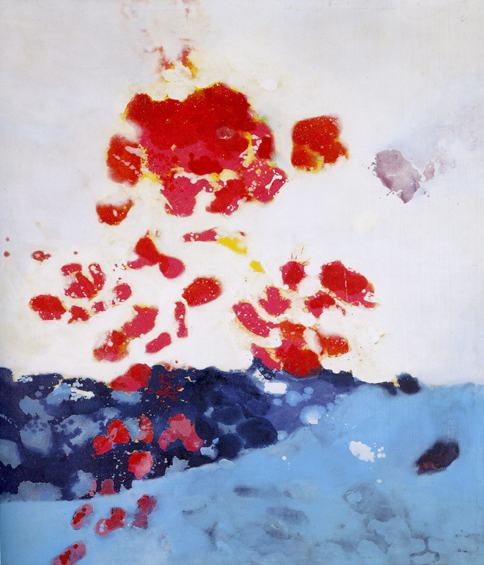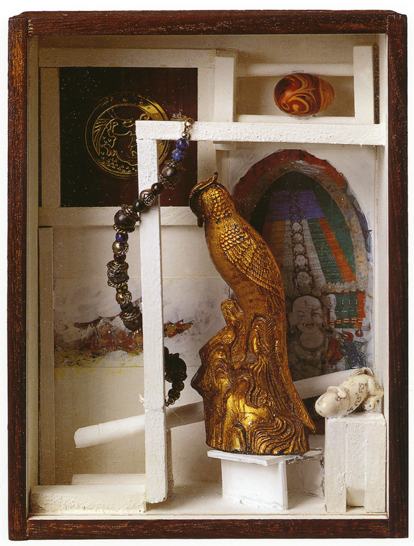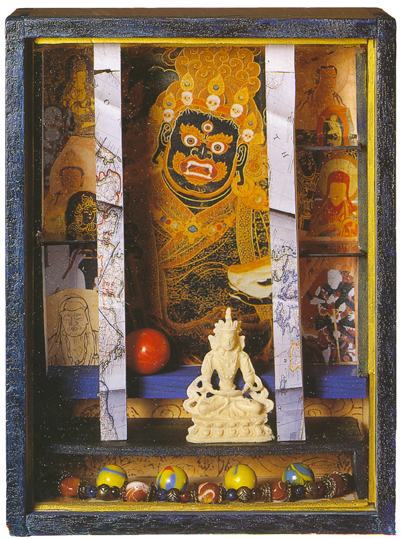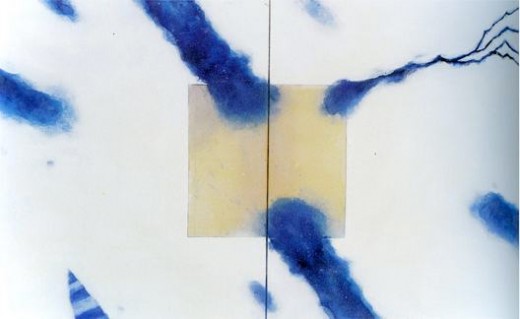
The Joy of Ancients
Oil on Canvas, 70 x 62 inches, 1961
“To me, the Mandala symbolizes the pose of the human mind. And, from the Mandala, I seek and find ‘absolute peace.’ To me, the world of beauty exists in the heart with pure peace, and in such a heart, artistic works that are honest are created. To me, Mandala does not necessarily denote the Buddhist Mandala. It is a state of mind.”
– Chun Sung Woo
Known for his Mandala works, Sung-woo Chun started his career by exhibiting 18 pieces of Mandala works in Seoul in April 1965 upon returning from a 12-year stay in the States. Since then, he has consistently exhibited many more Mandala works up until the creation of the Chungwha Mandalas in the 1990’s. Besides the title of Mandala Artist, Chun has been recognized by critics for “the natural description of the Oriental way of thinking by adopting abstract expressionism.”
In the 1950’s, the Pacific coast area of San Francisco Bay was one of the two central areas of the American contemporary art, developing the original school called the Bay Area Figurative School, distinguished from the New York Abstract Expressionism. It was in the San Francisco area that Chun studied as a student at the California School of Fine Arts (presently San Francisco Art Institute). CFSA played a central role in the flourishing of contemporary art in the Western area of the USA and majorly impacted Chun by impressing the fundamentals of abstract art that would later determine his artistic style.
Excerpted from writings of Chul-hyo Kim, Art Historian, General Manager of Archives & Library at Leeum, Samsung Museum of Art
Like other Koreans studying abroad, Chun took a deeper interest in his native country and the East when he was in the States than when he was living in his homeland of Korea. As a consequence, his abstract paintings were elevated to works more Oriental in themes and form. It is a well-known fact that abstract expressionism was more inspired by the thoughts and art of the East Asian region. Therefore, the prevalent view is to understand the worlds of Asian artists with Oriental lyricism, though different in technique, as a branch that absorbed the influence of abstract expressionism.
Excerpted from writings of Young Mok Jung, Art Historian, Seoul National University
50 Year of Refined Art:
Yung-nam Park on Chun Sung Woo
“I have a photograph that I cherish. It is a commemorative picture of the freshman at the Department of Arts, Seoul National University, at Yeon-geon-dong in 1969. In the first row, there is Mr. Jong-yeong Kim, Then the dean of the Department of Arts, full-time instructors at his sides, and the 70 students standing in the back rows. At the fifth seat from the right of the first row, there is Mr. Sung-woo Chun, or Woosong by pen name and at the back row. I was there, myself standing. The steep stairs were ideal for picture taking. The stairs were also meaningful because the students walked up to the art studio through those stairs for their classes at the Department of Painting. Walking down the stairs, we used to enjoy the entire view of the campus below – the stairs were indeed memorable to students majoring in painting.
It was in the art studio that I met Woosong. It was a landscape painting class. Pointing to one of the student’s landscape paintings, he used to start by asking “shall we try turning this picture upside down?” followed by the next question, “shall we try turning this picture upside down?” followed by the next question, “How do you feel looking at the same inverted picture?” When there was no particular answer, he then continued, “If you don’t feel uncomfortable in looking at the inverted picture, you can be reassured that harmony exists among the colored spaces. This is the harmony that makes our visual perception comfortable.” His lecture went on to explain that the forms in colors are necessarily correlated with the spaces of their background. He added that, if we are to paint apples, the background of the apples is as important as the apples themselves. In other words, he suggested that good management of the background automatically lead to the natural form of apples.
His remark in point is still vivid in my memory. Even though I had been trying to paint for a long time before coming to the College of Art, I had no idea until that moment that the form of the object is determined by the space of the background. I instantly fell into an abyss rather than joy by the new finding. I felt that I was being emptied in to a void. When I had finally emptied myself, I got to be accustomed to being refilled little by little, and it was quite joyful, It reminds me of the concept of Positive Space and Negative Space. To create a space of depth, there should be some power for the space of colors to push and pull each other. It was a first-time experience for me, who had thought that colors were always subordinate means of expressions, to realize that colors can be independent subjects that take dynamic forms. This is how I first met Mr. Chun and 40 years have passed ever since.”

Mandala Box: Golden Phoenix #1
Mixed Media, 10 x 7 x 3.5 inches, 1998

Mandala Box: Yacha
Mixed Media, 10 x 7 x 3.5 inches, 1998

Chungwa Mandala: Cloud Sea #72
Oil on Canvas, 24 x 41 inches, 2004
Download CV [pdf]
Keywords: interdisciplinary, Korean-American, men, painting, sculpture

